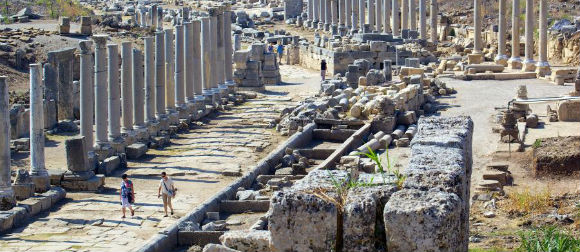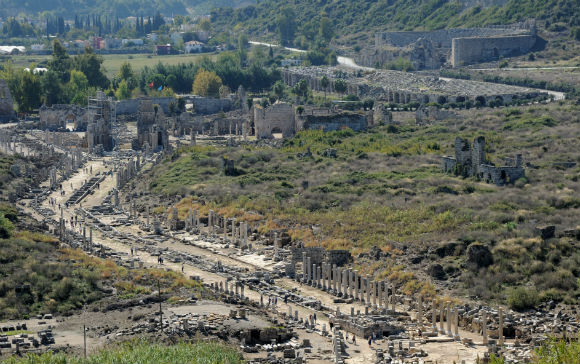The most impressive ruins of the Pamphylian coast are at Perge, at about 15 km east of Antalya. Perge was originally founded by the Hittites around 1500 BC. and was known as Parha. It was a successful trading centre near the Aksu (ancient Kestros or Cestrus) river when Alexander the Great arrived in 333 BC. He was welcomed in by the inhabitants and used Perge as base for his Anatolian campaigns. Alexander was followed by the Seleucids under whom the city prospered and Perge’s most celebrated inhabitant, the mathematician Apollonius from Perge lived and worked. Apollonius was a pupil of Archimedes and wrote a series of eight books on geometry. In 188 BC Perge became part of the Roman Empire during which the city flourished. Most of the surviving buildings date from this period.In 46 AD St. Paul started his journey in Perge (biblical Perga) and preached his first sermon here. Perge gradually declined during the Byzantine period, as the Aksu river silted, but remained inhabited until Selçuk times after which it became abandoned.
A visit to Perge starts by entering the archeological site through the Roman Gate, built during the reign of Septimius Severus (193-211 AD). Proceeding through the gate, to the right is the Agora or market place. This structure of 75 x 75 m dates back from the 2nd century AD. The center courtyard and shops were surrounded by a wide stoa, a covered walkway. The floor of the stoa and shops was made of colored mosaics. The agora was not only the centre of Perge’s trade, but was also a place for meetings as well as a forum for political, social, and philosophical discussions. The next building is the Hellenistic city gate that dates back to the 3rd century BC. This is certainly the most imposing building of the city and was cleverly designed to protect the city with its twin towers and its horseshoe-shaped courtyard at the back. It is thought that the towers had three floors and were crowned by a conical roof. In the year 121 AD, the horseshoe-shaped courtyard was rededesigned as a courtyard of honor. Behind the courtyard stood a triple arch. Around the arch there are about dozen inscriptions connected with Plancia Magna who lived in the 2nd century AD. She was the daughter of the governor, a priestess of Artemis Pergaia (Diana) and a benefactress to the city. Plancia Magna had the arch decorated with the statues of the emperors and their relatives.
After passing through the Hellenistic Gate and courtyard, one enters a broad, marble-paved double-colonnaded street measuring 300 meters in length that extends from the main gate to the acropolis. The street is 20 m wide and is divided in two by a 2 meter wide water channel running down the middle. At the end of the colonnaded street is the Nymphaeum, a triumphal fountain from where a stream flowed down into the water channel. The nymphaeum or nymphaion is an ornamental semicircular structure and dates from the reign of Emperor Hadrian (130-150 AD). A statue of a river god Kestros was located in the center of this huge fountain. Behind the nymphaeum is the acropolis with some remains of the Byzantine period. To the west of the nymphaeum are the remains of a palaestra dating from 50 AD and dedicated to the Emperor Cladius (41-54 AD).
Returning back to the entrance, there are the excavated Roman baths located southwest to the agora. Out of the site proper, is the horsehsoe-shaped stadium, the largest in Asia Minor, measuring 234 m by 34 m. The stadium had a seating capacity of 12,000 people supported by massive barrel-vaulted constructions. Just beyond the site entrance is also the theatre, which is of the Greco-Roman type and could seat 15,000 people. Unfortunately, it is for some time under reconstruction and unfortunately closed to visitors.
Perge,



I didn't expect much from ruins in Turkey but was pleasantly surprised. I would recommend the tour featuring Perge, Apendos and the waterfall.
This wonderful site was inhabited by Hittites many centuries prior to the arrival of the Greeks, and after the departure of the Romans it declined under Byzantine stewardship, although its importance in the life of St. Paul may have suggested a more favourable outcome. It offers one of the most dynamic impressions of what it was like to live in…
This is where St Paul gave his first ever sermon at Perge – great to walk amongst the old Roman ruins here and imagine how this town was all those years ago.
Much smaller than Pompeii (Italy) so not too daunting for all ages. Good maps and descriptions covering the different areas and some interesting restoration work being undertaken. Well worth a visit.
Perge is a historical site, 30 kms away from city center. It worths going there to explore excavated statues. I would recommend you to read a book about this site, to be more familiar with the all the details, if you won’t get a tour guide. It was opened after a long term renovation with a great support from the…
Very close to the hotel. We just rented a bus with 10 people. It took only 20 minutes and we spend more than a hour with a guide who told us the history about thede place.
What I enjoyed most about Perge was the variety of carved ruins. The site, including inside the stadium, was filled – seemingly littered – with pieces showing various decorative designs. The baths have been restored and through our guide it was interesting to learn and see how they were heated, and how the water was distributed and circulated.
Very beautiful place, magnificent scenery. we went on august this year, not really recommended if u r sensitive to heat, my gf didn't enjoy it as much as i did, also there are many excavation areas that are prohibited, and the ruins are not taken care of as it was in other countries, but still u get that indiana jones…
Wonderful Roman city. A must for every vist to Antylia
Good value for money, amazing ruins- expensive ice creams